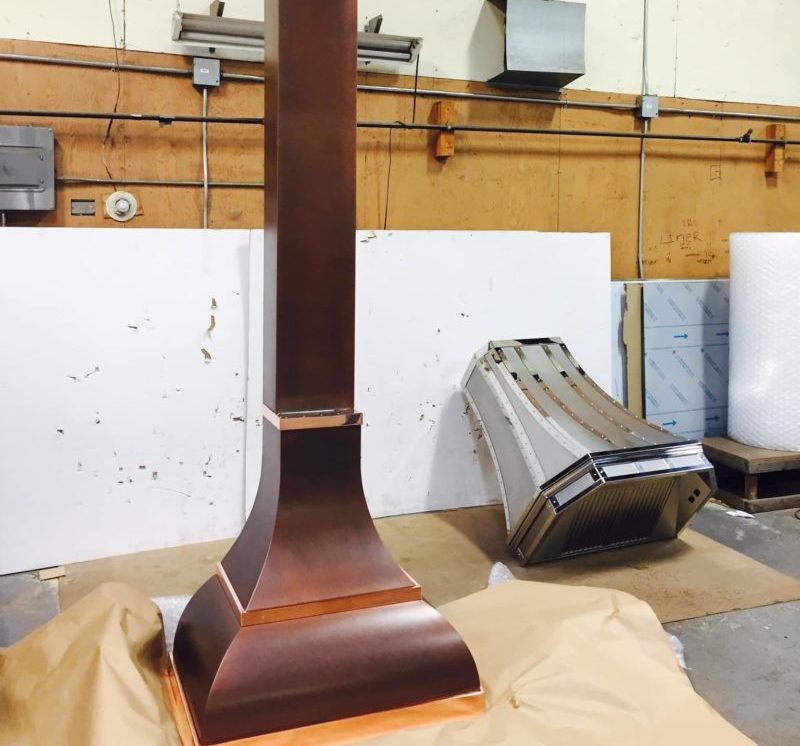Generally, you need to hear more airflow noise than you hear motor noise, but this may change depending on the type of duct you have, and how long it is. Noises that can require more investigation involve rattling, vibration, which can indicate that installation wasn’t performed properly and something is loose.
A great way to measure power in kitchen hoods is by using cubic feet per minute (CFM). The CFM tells you about the power amount that the kitchen hood puts out. In simple words, it states how much air the fan can push inside the range hood.

Commercial or other kitchens that cook often can have range hoods with a high CFM than residential kitchens do. You should have a high-powered range hood if you cook more often, or if you cook spicier dishes that produce a smell, smoke, heat, and grease. The higher the CFM, the faster you can clear out the kitchen. Although, too much CFM can be overkill for the average residential kitchen.
The choice of the cooker hood is a determining factor
Choosing a cooker hood is a determining factor. Not all cooker hoods operate at the same speed or power or produce the same noise. Few high-performing ones may be noisy. It is essential to select the right hood if you don’t want to be disturbed by the noise. Now, noise levels are specified in decibels (dB) on the appliances. This means you can compare different cooker hoods and select the one that offers a great compromise in terms of extraction power and decibels produced.
The non-return valve has come loose
Most cooker hoods have a non-return valve that can prevent the expelled air from re-entering. From time to time, this valve can produce a clapping sound. This may be caused by grease or general wear and tear, or maybe because of the valve not being installed appropriately. You can inspect this component yourself. It’ll be present at the point where the air exits the hood. If the valve moves too freely and produces noise, then you can apply a piece of blu tack to diminish its flapping movement.
The carbon filters are worn out
Active carbon filters, as utilized on recirculating hoods, need to be replaced once every 3 months. If these filters get too worn, they may crack and can let carbon small pieces to pass through. These carbon pieces will then finish up generating noise, the same as the way pebbles do when shaken in a box. If the filters are damaged, you should replace them.
The impeller isn’t tightly screwed on
The impeller bolts onto the motor spindle and will be made from plastic. Impellers can sometimes finish up rubbing against a foreign object, or they may break. If either of these things happens, it’ll generate noise. Inspect the general situation of the impeller, and ensure the bolt that holds it in place is appropriately tightened.
The motor casing and mounting is cracked
The motor casing and mounting are made from plastic, and this plastic can crack or break. When this occurs, the motor will not be held in place appropriately, causing it to move around and generate noise when the hood is operating. It will bang against the hood’s metal casing and also it can rub against the impeller, which means that there is a risk you can hear a loud sound. You should inspect the condition of the motor casing and mounting yourself; it is possible to see them using a torch.
The extractor fan motor is rusty
The extractor fan motor allows the cooker hood to extract the air from the room. If the motor becomes rusty because of moisture or gets damaged by grease build-up, it won’t be able to run appropriately, causing it to produce a loud whirring sound. If this happens, replace the motor.
Fixing Range Hood Noise
The range hood may be damaged and it’ll make noise when it’s running. The more noise that’s produced is due to the damaged fan. However, you can fix noisy Rangehood and have a fan working as if it’s brand new by following these guidelines:
- Trace the button that’s present in front of the range hood and then turn on the power. Wait for a fan to pick up the speed and recognize where the noise is being produced. Pay attention to the noise that’s produced, noting whether it’s intermittent noise or constant.
- Find where screws holding the hood’s cover are. Utilizing a screwdriver, remove these screws, and then pull off the cover so that you have access to the fan. Set the cover in a place that’s safe as you’ll require it after fixing the fan.
- Observe the fan and recognize if’s cracked or it has damages on blades. Then, remove the screws holding the fan. Take the fan out.
- The fan can require cleaning or straightening the blades, etc. If this’s the case, then do that. However, if the damage is severe, you can want to replace the blades.
- Match the blade from the range hood with a new one and install it on the top of the range hood. Tighten it with the same screw unless using a screwdriver.
- Put the hood’s cover back in place. Tight screws and then test the fan to find out if it’s working appropriately without the noise.
That’s it. As you can see, fixing a noisy range hood is so simple by following those. You can do it by yourself. However, in following these guidelines, you must read as well as understand them. It is better to hire some person who has enough knowledge of fixing vent hoods.
